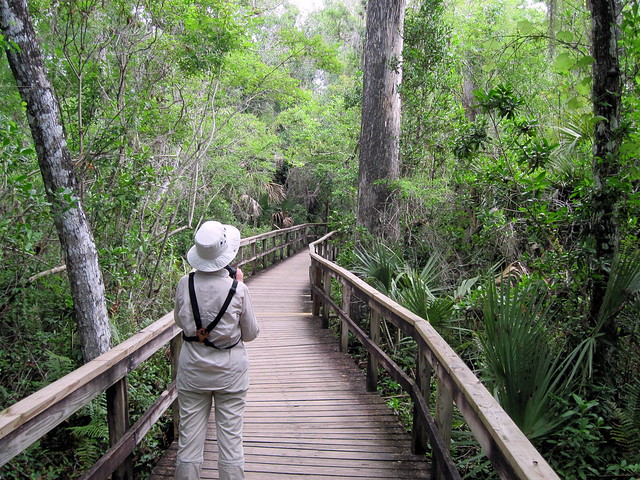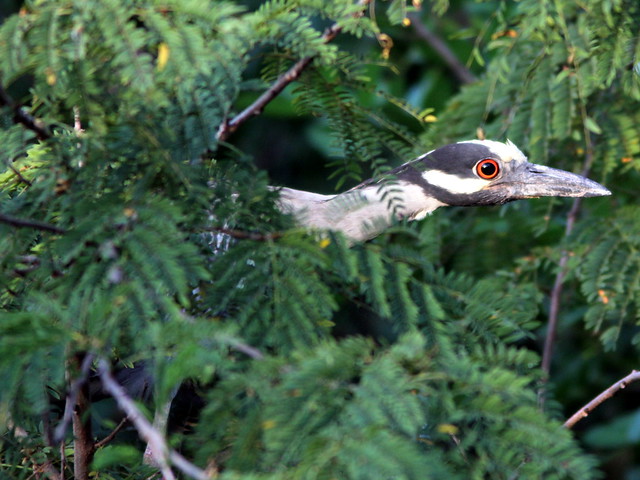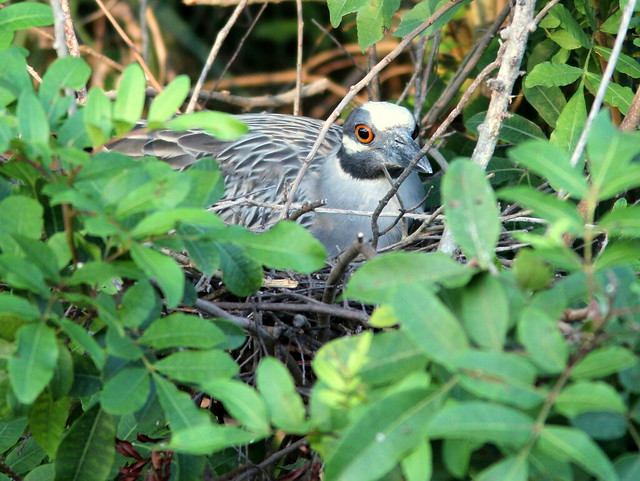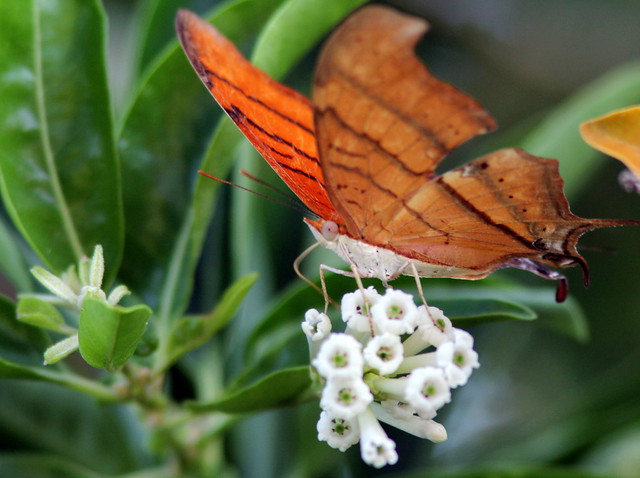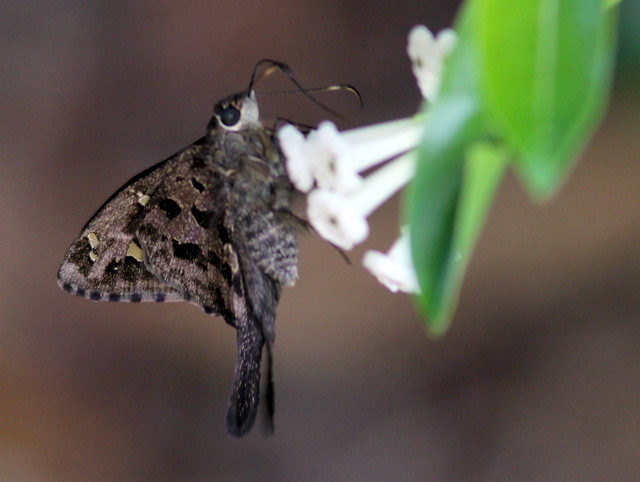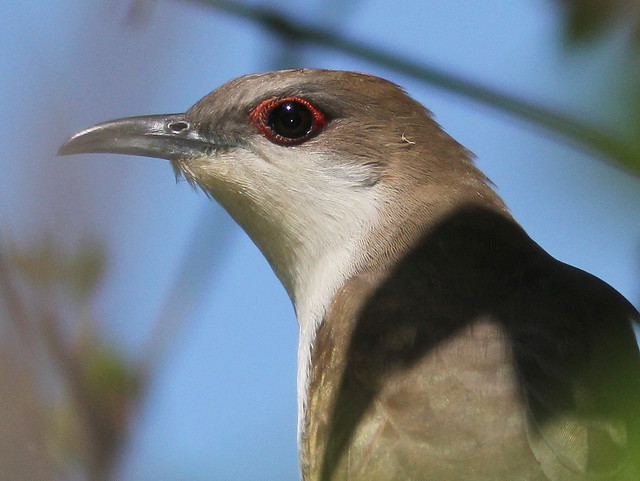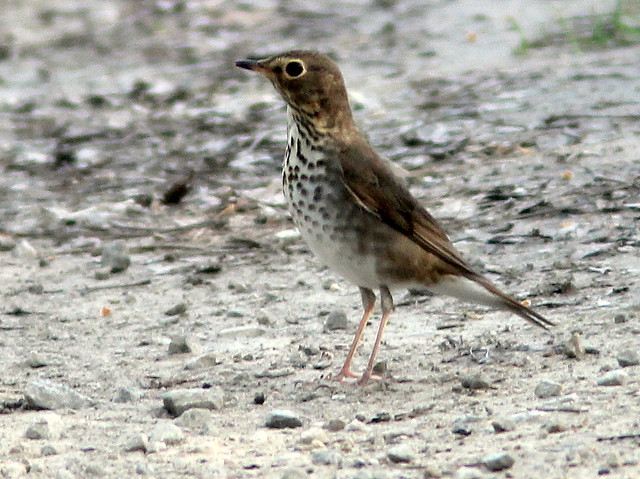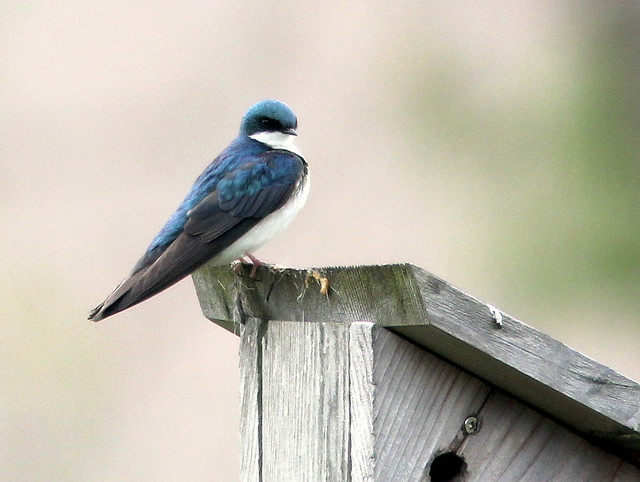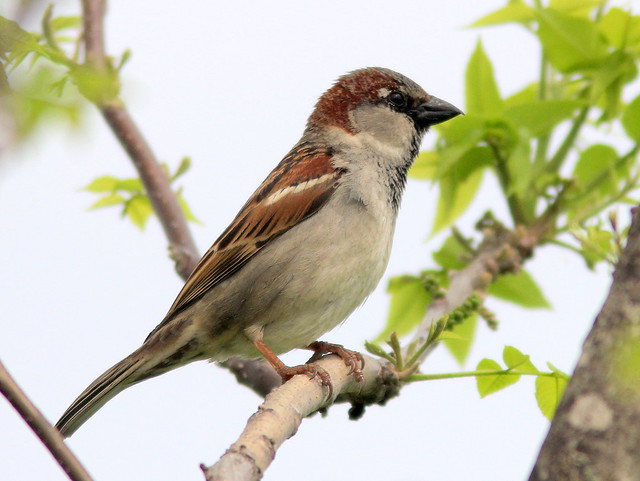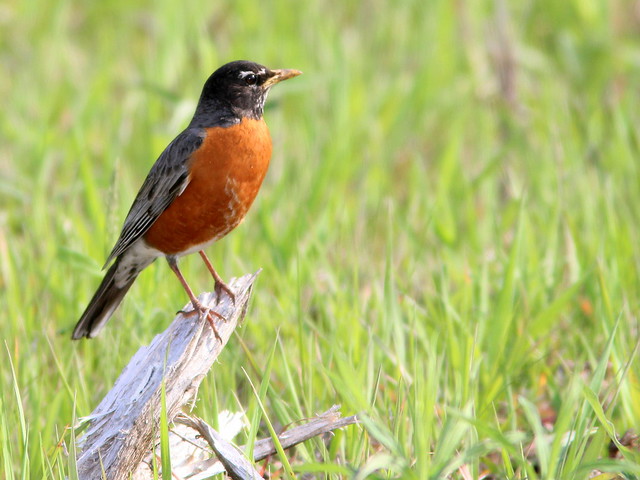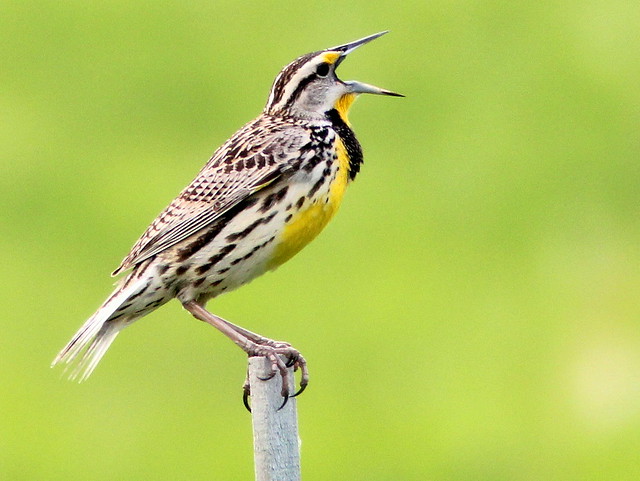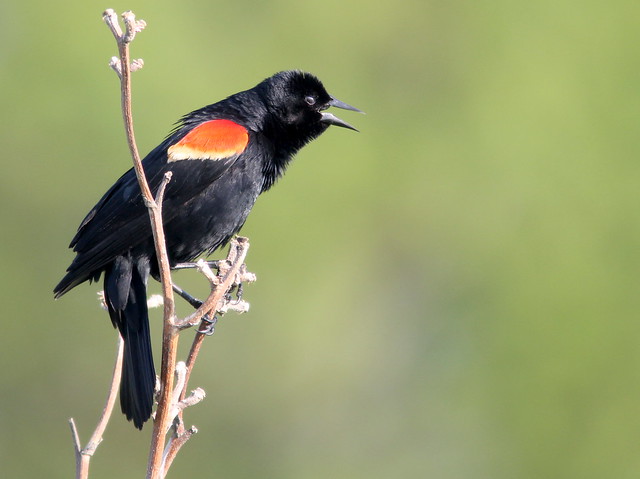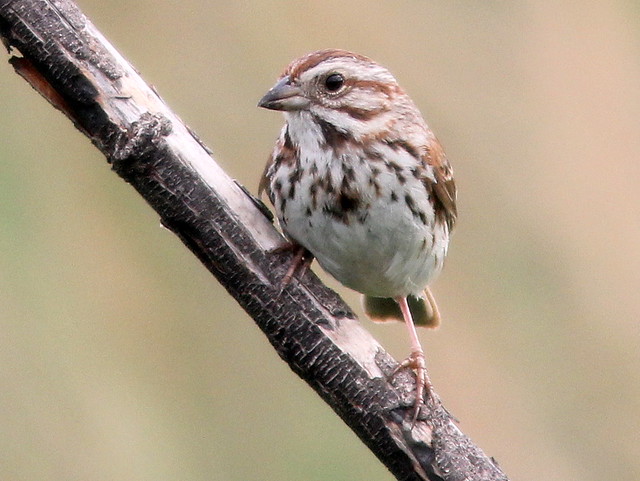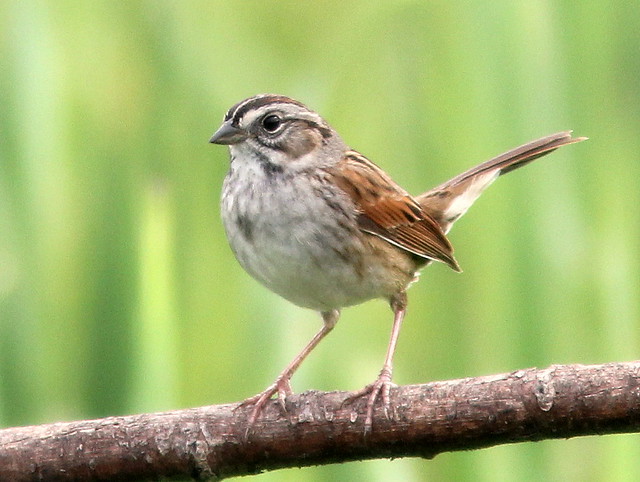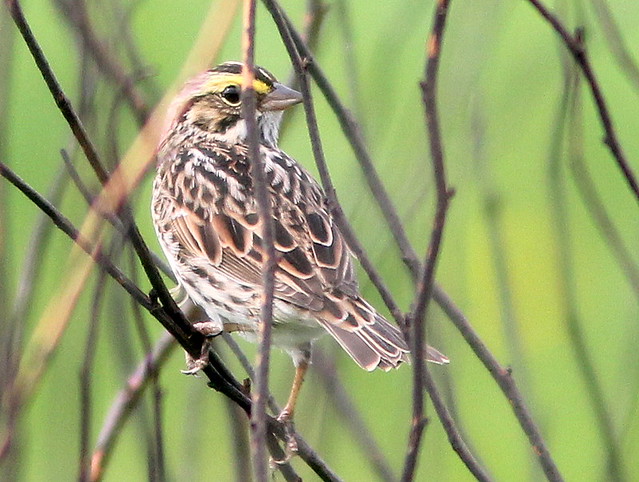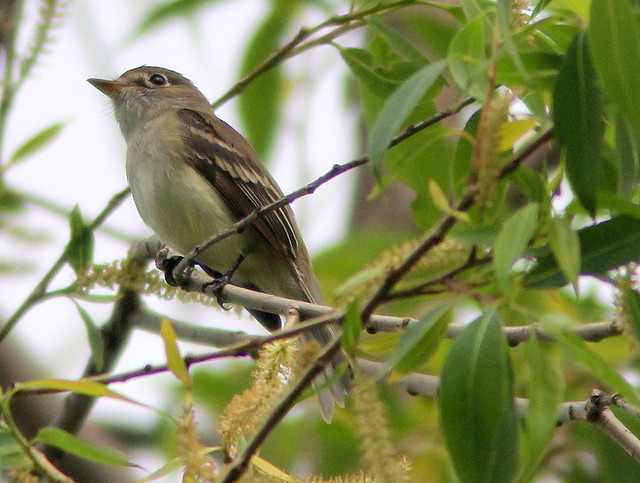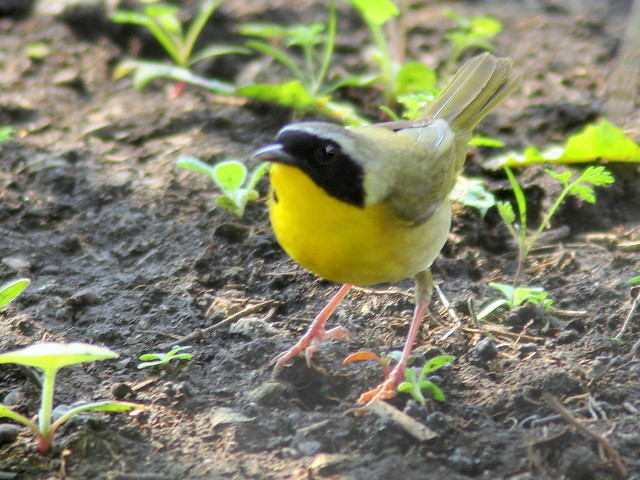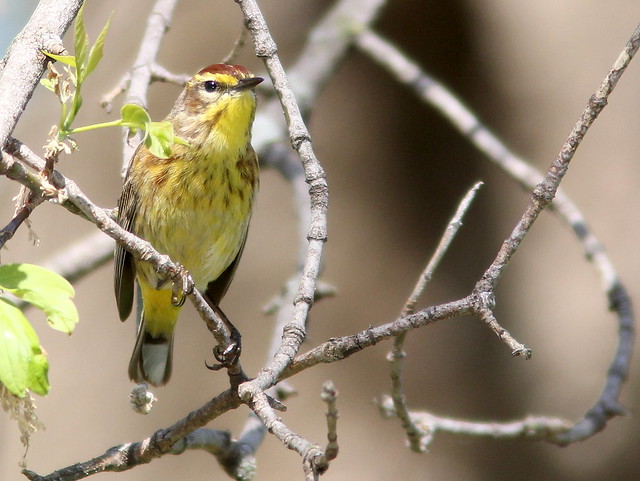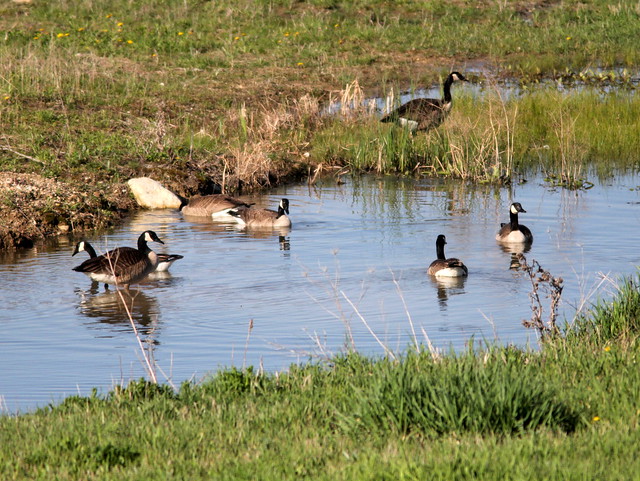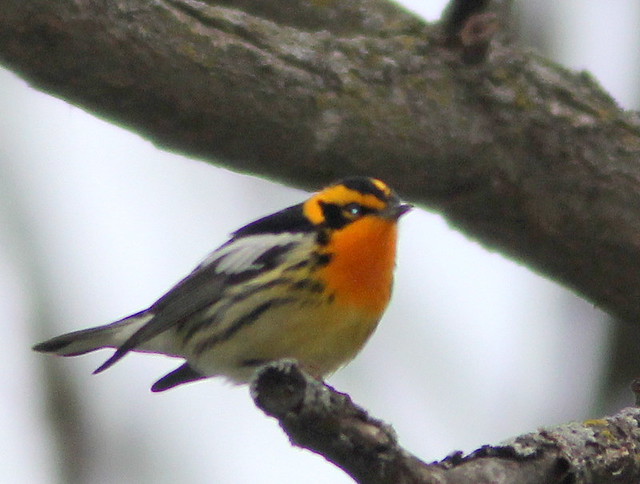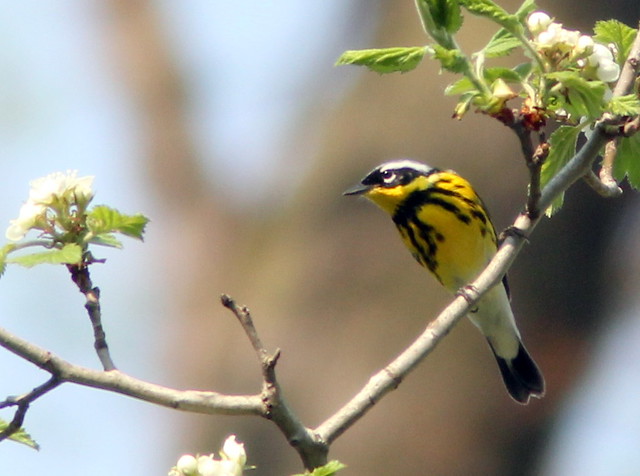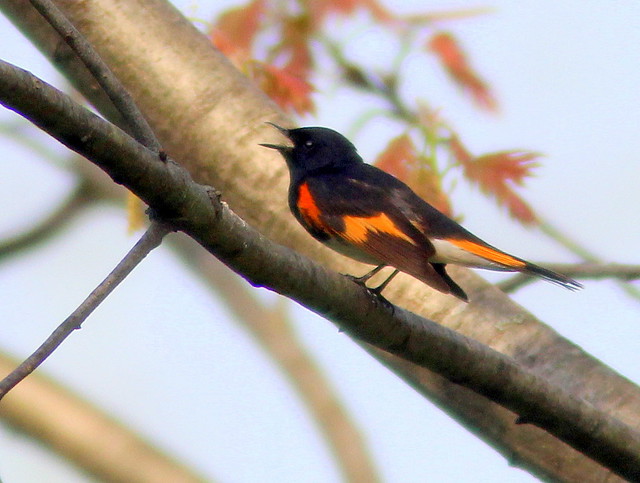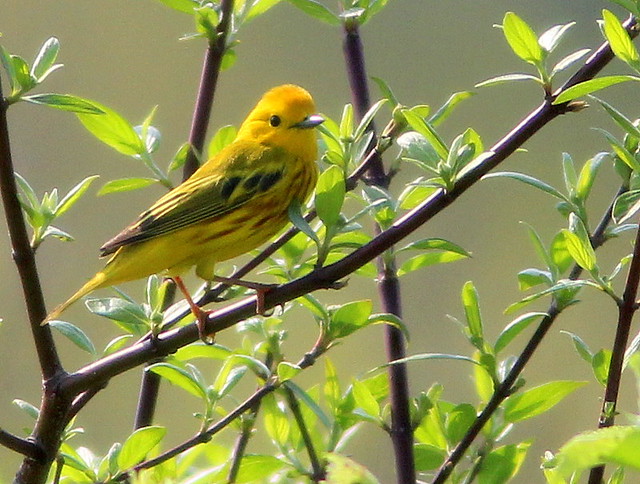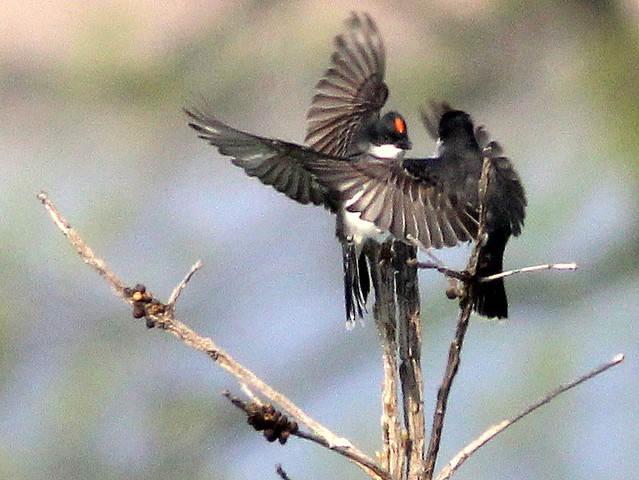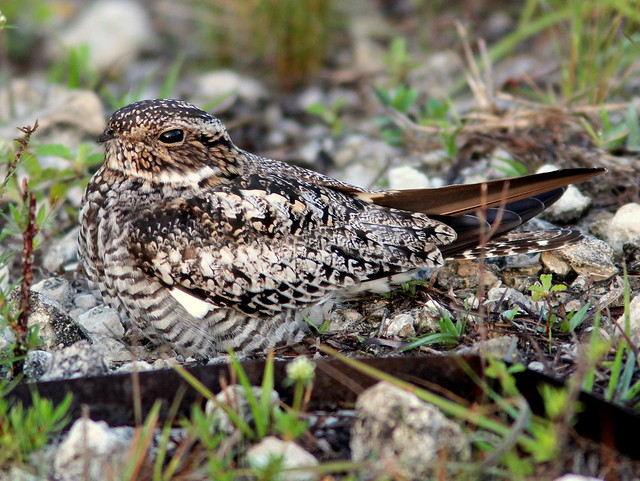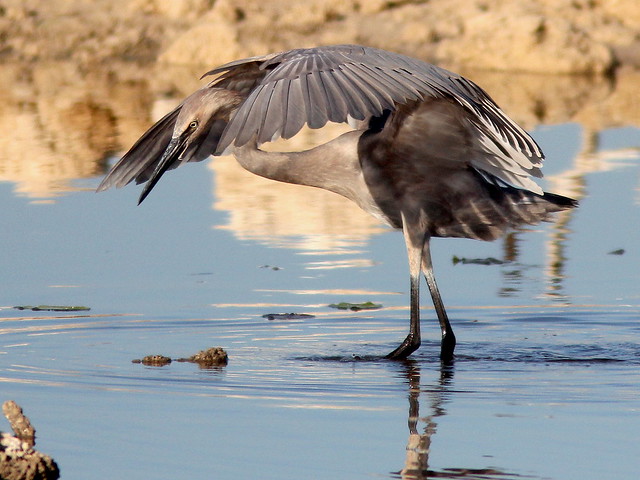Posted by: Ken @ 7:16 pm
Arriving back home in Florida this past week, we looked forward to visiting a small, newly-discovered Yellow-crowned Night-Heron rookery in our local birding patch. Scott, a non-birding neighbor, discovered it, tucked away in a corner where we simply never ventured on our daily walks.
We first met Scott walking his dog early one morning in the wetlands next to our home. He asked about the birds we were seeing, and was interested in my birding and photography equipment. He was curious about identifying the birds, though he did not own a field guide. Then, a couple of months ago he went out and purchased a huge pair of Porro prism binoculars. They were about 30 power, and hung down almost to his knees. Their field of view was so small that he could not tell where he was looking, and needed a tripod to keep them steady! Scott was quite proud of their bargain price, but after trying to use them, he decided to donate them to “Audubon.” I suggested that a shooting club might be able to use them for spotting the targets. Recently, he bought a manual focus 300 mm telephoto lens for his point-and-shoot camera, and has captured some nice images.
While we were in Illinois, Scott provided us with daily briefings on events and sightings in our birding patch, e-mailing photos of his subjects. They included good shots of egrets and other herons, hawks, Bald Eagles and Black-necked Stilts. He asked about the identity of a bird with big red eyes. I did not have to look at his photo to know that it was probably a night-heron, and sure enough it was– a Yellow-crowned Night-Heron. Since finding a group of several heron nests beside a canal, my neighbor has become an even more avid birder. I met him at 7:20 PM on our second day back from Illinois, and he guided me to the small rookery. We braved the mosquitoes and stayed until it got too dark for photos.
The nests included that of a Green Heron, with three recently-fledged youngsters. Note that remnants of natal down among the feathers of the smallest of the trio: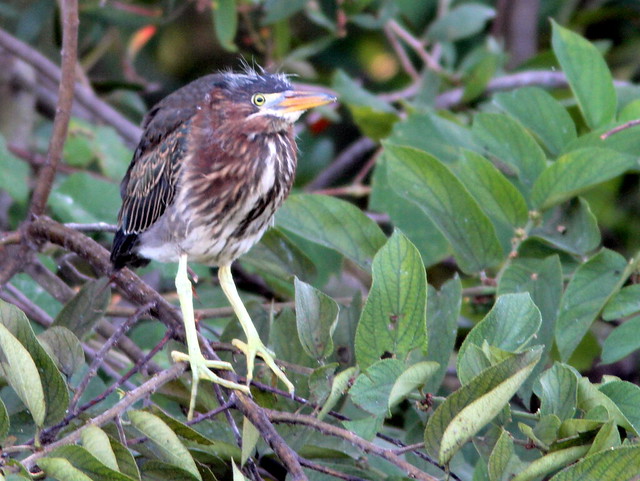
The adult Yellow-crowned Night-Herons are beautiful subjects, and I shared Scott’s enthusiasm as they peered out at us through the branches:
Their red eyes are conspicuous, indeed:
Five or six pairs were roosting in the trees…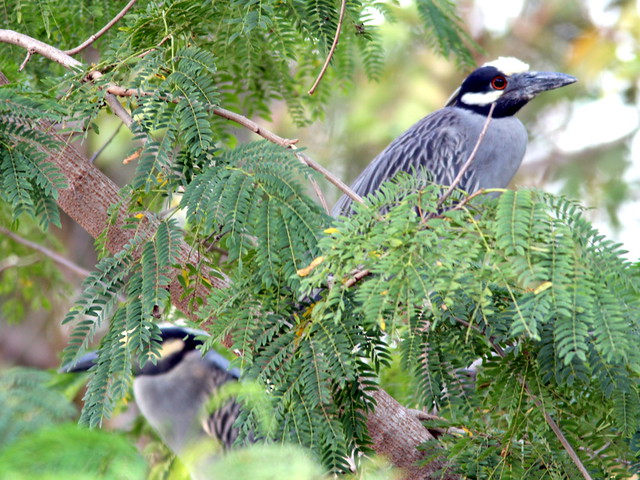
…or sitting on eggs in their nests:
Mary Lou wanted to see them, and she and I returned to the rookery early the next morning. The sun was rising directly behind the nest trees, making photography difficult, but I obtained a few more portraits: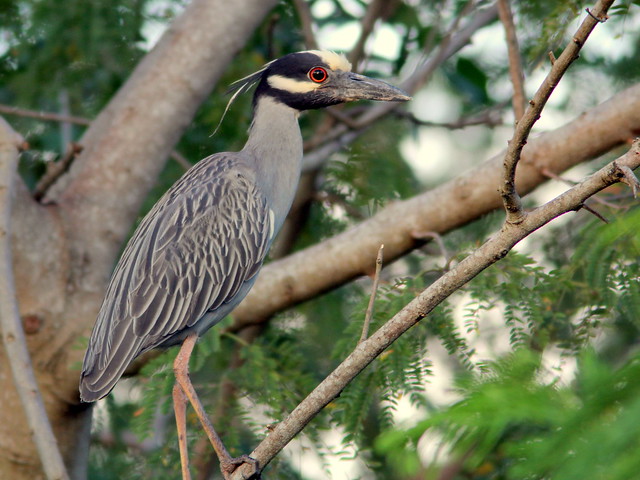
On
our way back from the one mile walk to the rookery, we saw that the
immature Reddish Egret, first found on March 4th, was still present on
the Harbour Lakes impoundment: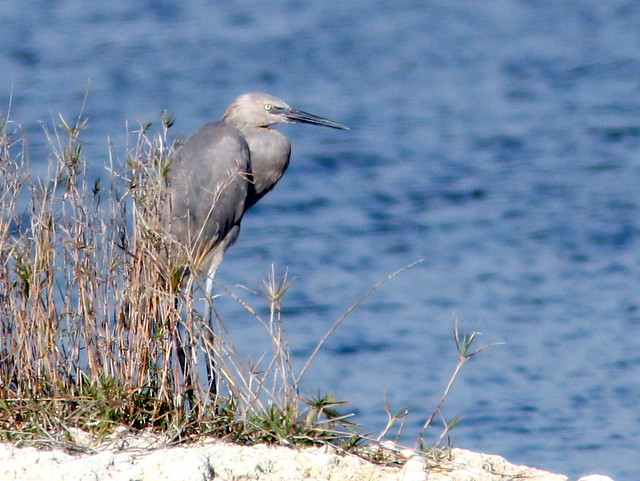
It was joined by a sub-adult Little Blue Heron that was about half way in its change from white to blue: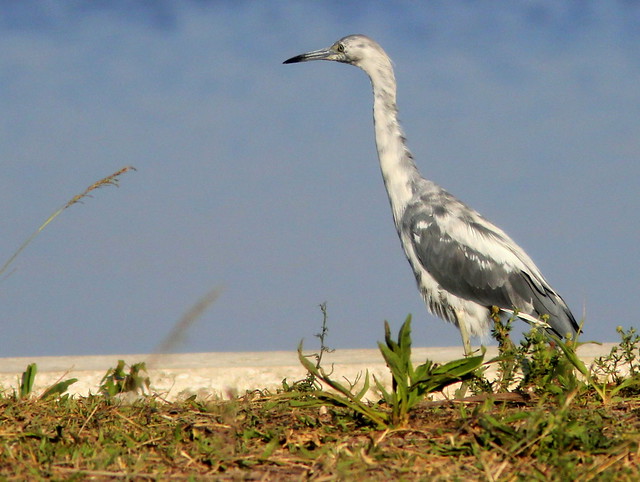
Its wing coverts, tail and five primary feathers on each wing were already dark: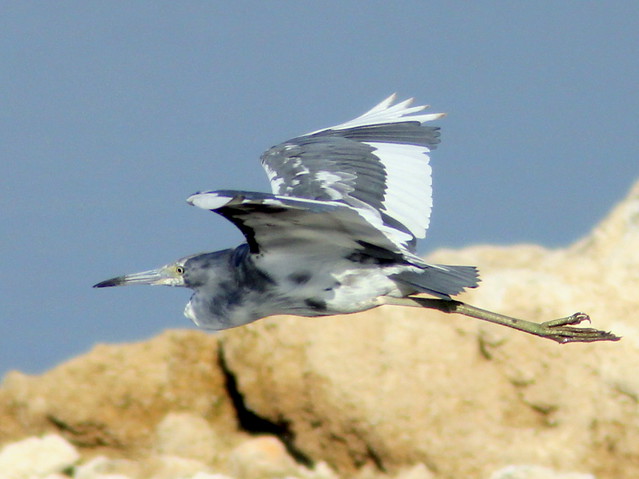
A couple of days later, the mud flats were almost dried up, and the Reddish Egret had disappeared. The Little Blue Heron was still there, and a Boat-tailed Grackle chased after it, revealing the symmetrical feather replacement pattern:
A Green Heron flew in and rested briefly on a boulder:
Migratory birds had departed, and there was almost an absence of song as the resident birds concentrated on raising their young. A male Northern Cardinal whistled feebly from a perch next to the lake:

The only other song was that of a Red-winged Blackbird, as it broadcast its territorial imperative*: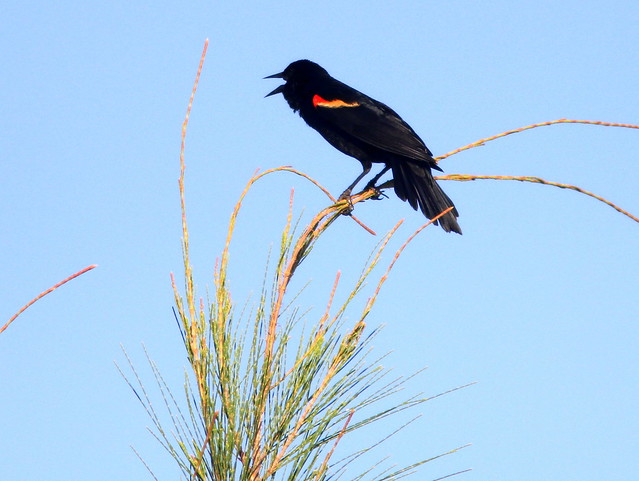
Whenever birding quiets down, the butterflies become more interesting to me. This is my first photo of a Ruddy Daggerwing (click on image for more views):
Another new and unusual species for my butterfly image collection was this long-tailed Dorantes Skipper (awaiting confirmation of ID– click on image for more information):
When we arrived home from our walk, a Tricolored Heron was waiting for us in our back yard, as if to remind us that, indeed, we were back in Florida:
* See: Robert Ardrey, The Territorial Imperative: A Personal Inquiry into the Animal Origins of Property and Nations, 1966.
“Of Men and Mockingbirds”
“…We may also say that in all territorial species, without exception,
possession of a territory lends enhanced energy to the proprietor.
Students of animal behavior cannot agree as to why this should be, but
the challenger is almost invariably defeated, the intruder expelled. In
part, there, seems some mysterious flow of energy and resolve which
invests a proprietor on his home grounds. But likewise, so marked is
the inhibition lying on the intruder, so evident his sense of trespass,
we may be permitted to wonder if in all territorial species there does
not exist, more profound than simple learning, some universal
recognition of territorial rights…”
This is nearly the end our third and final week here in Illinois, and for the past several days I have been pretty much side-lined. The weather took a nasty turn, with cold rain and light frost two mornings last week, and on top of that I have come down with a nasty sinus infection that turned into bronchitis and asthma. Waiting for the antibiotics and inhalers to kick in does give me time to reflect upon the past two weeks. There is also a glimmer of hope that I can get out at least one more day before returning to Florida.
This past week, I can credit Mary Lou for finding the best bird of our Illinois visit, her 506th North American life bird. We were walking in the West Aurora Forest Preserve in Kane County, when we heard some loud cackling and squawking noises that persisted for about 10 seconds. They seemed to be from a bird, but were like nothing I had ever heard before. The nearest I could imagine would be a chicken-like species, but did not think that bobwhites or pheasants ever made sounds like that. Then, she spied a fairly large bird low in a tree right next to the trail. As it was partially hidden among the leaves, I almost dismissed it as a thrasher or a grackle. It flew a few yards to another tree and we noted its white undersides, plain brown back, and drooping tail. It lacked rufous in its wings, characteristic of the more common Yellow-billed Cuckoo.
Then it softly called “ku-ku-ku…ku-ku-ku…” and I recognized its call as that of a Black-billed Cuckoo:
In addition to its all-black bill, it also had small under-tail spots and a red ring around its eye:
We also encountered a Swainson’s Thrush, with is drab brown back and tail and prominent eye-ring:
Celebrating International Migratory Bird Day this past weekend, I helped staff the Kane County Audubon Society booth at the Bird Fest. In anticipation of leading a bird walk, Mary Lou and I scouted out the planned route, located at Peck Farm Park in Geneva, Illinois. On a sunny and warm morning, two days before the Fest, we found lots of birds, some of which were seen up close and personal– just the kind of views that we hoped would enthrall the anticipated (mostly young) participants.
As we entered the path for the bird walk, we saw that Tree Swallows had occupied one half of a double-sided bluebird house:
The second member of the Tree Swallow pair stood guard in a small tree next to the nest:
For my forthcoming walk, I planned to provide my interpretation of the reason why the bluebird houses were placed back-to-back. Tree Swallows aggressively defend their nesting territory against all other bird species, but especially other Tree Swallows. It has been shown that pairing of bluebird houses, either back-to-back or only a few feet apart, and then leaving a space of some 100 yards before erecting another pair of boxes, may provide bluebirds a better chance at nesting in one of the paired boxes. It seems that the Tree Swallows are more tolerant of other species if they are able to successfully defend their territories against other Tree Swallows, and perhaps the two species assist each other in this defense. House Sparrows can disturb this plan, as they claim the boxes earlier in the spring, and usually are able to displace bluebirds. The sparrows should generally be removed if they begin to colonize the bird houses, as they can eventually displace all other species.
Indeed, the other half of the bird house had already been taken over by House Sparrows. The male was perched nearby:
The kids love robins and they were singing all around the trails. I decided it would be fun if I asked them to close their eyes and try to identify all the sounds around them:
I hoped the kids would be astonished by the sound and beauty of an Eastern Meadowlark:
Red-winged Blackbirds are so easy to identify by sight and sound, were also abundant:
American Goldfinches were numerous:
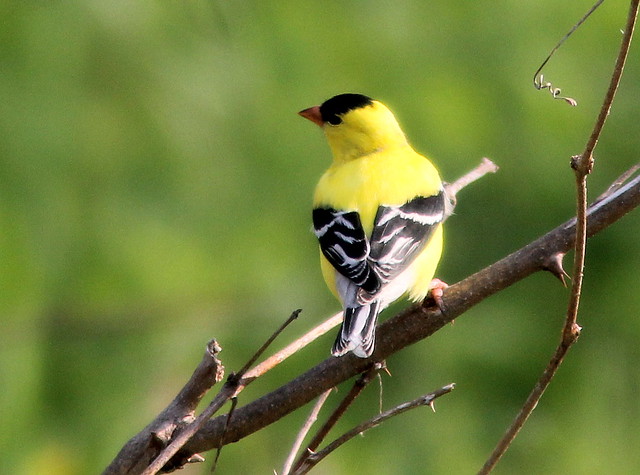
An Indigo Bunting sang from the lower branches of a tree next to the lake:
Among the Little Brown Birds (LBBs) were a Song Sparrow…
…and a partially hidden Savannah Sparrow, all readily distinguishable to a beginner by voice, if not appearance:
We heard the “CHE-BEK” calls of three Least Flycatchers:
On the way back, we identified the “FITZ-BYEW” calls of two Willow Flycatchers in the small willows along a creek (the red barn is out of focus behind the bird):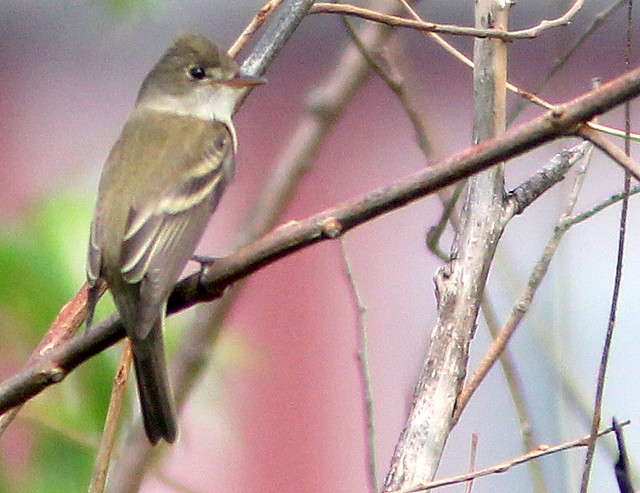
A territorial Common Yellowthroat, singing one of the endless varieties of its “WICHITY-WICHITY-WICHITY” song peered up at us from beneath a shrub that we were sure would soon be a nesting site:
We had seen 32 bird species in the course of an hour, and I looked forward to the Bird Fest, only two days away. Unfortunately, a strong cold front rolled in the next day, and temperatures dropped from near 80 degrees into the 40s that afternoon. It rained during the night, and in the morning we set up our booth on the porch of the Peck Farm Park interpretive center, fighting high winds from the north and a wind chill in the low 30s that kept the crowds away. I led the 10:30 AM bird walk for five hardy participants. One was a little girl who wore a flimsy fleece jacket but who participated enthusiastically. After 15 minutes the others gave up, but she and her father kept with me as we tallied a paltry count of 13 species over a half hour. By then I was miserable with chills and fever, but her spirit was inspiring!
We were greeted by unusually warm weather upon our arrival in northeastern Illinois. We got out early most mornings and found that, indeed, we had caught up with the spring migrants that are now mostly gone from Florida. This is actually an inaccurate statement, as most of the birds we are seeing up here have almost certainly followed the Mississippi Flyway, an entirely different migration route than the Atlantic Flyway that runs through peninsular Florida up into the northeastern states and provinces. However, individual species, such as the Palm Warbler, may follow unique circular patterns of migration.
The dull “Western” race of Palm Warbler is very common all winter in Florida, and we rarely see the bright “Yellow” eastern form such as this one I photographed this past week here in Illinois:
The Western race of the Palm Warbler is not seen along the East coast in spring, but is found farther inland during that season. In the fall, these birds depart from breeding grounds in northwest Canada and move almost due east until turning southward along the Atlantic Coast, with much of the population spending the winter in Florida. In spring, they fly more directly northwest to their summer homes. The eastern Yellow Palm Warblers winter more to the west, from northern Florida into east Texas, and their spring migration path actually crosses that of the northbound western race. This is vividly illustrated on this animated eBird Occurrence Map
Spring migration can be full of surprises. Our Illinois front “yard” is actually a disturbed plot that was abandoned by the developer when the company went bankrupt. It contains a small “fluddle” (a common name that local birders give to low spots in the prairie that fill with water from snow-melt and spring rains):
One morning I happened to look out our second-story bedroom window and was amazed to see the white head of a “Blue” morph Snow Goose that was foraging with a small flock of Canada Geese. Its behavior raised an interesting question.
I took this and the above photo through the window pane:
The Snow Goose tended to associate with one of the Canada geese, and the two spent much of their time apart from the rest of the flock. A couple of weeks ago, a neighbor who lives on the lake at nearby Jones Meadow Park sent me photos of a similar Snow Goose that also was associated with one Canada Goose, suggesting that they may be bonded. The far northern edge of the breeding range of Canada geese overlaps with that of the Snow Goose. The latter species is known for “dumping” its eggs in neighboring nests. Is it possible that this Canada Goose raised this particular bird? I could find no specific references to this on the Internet.
Warblers are the main attraction in the spring. Serendipitously, a Nashville Warbler flew up just as I depressed the shutter. Believing I had captured only an empty branch, imagine my surprise when I viewed my photo on the computer screen and saw what looks like a photo-shopped image of the flying bird “perched on air”:
Atypically, this male Common Yellowthroat occupied an open perch from which to sing: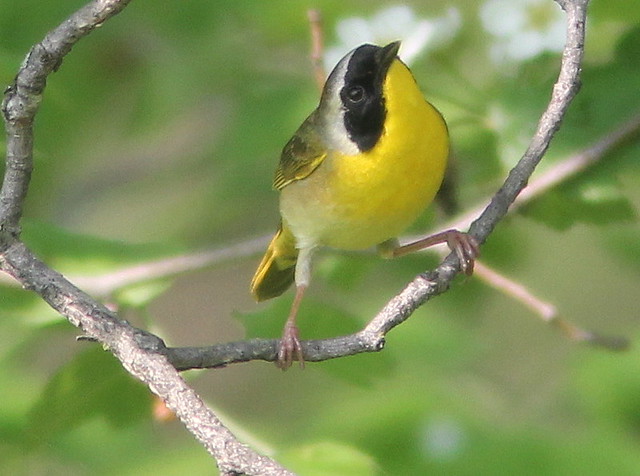
It was great to see Yellow-rumped Warblers in bright spring plumage: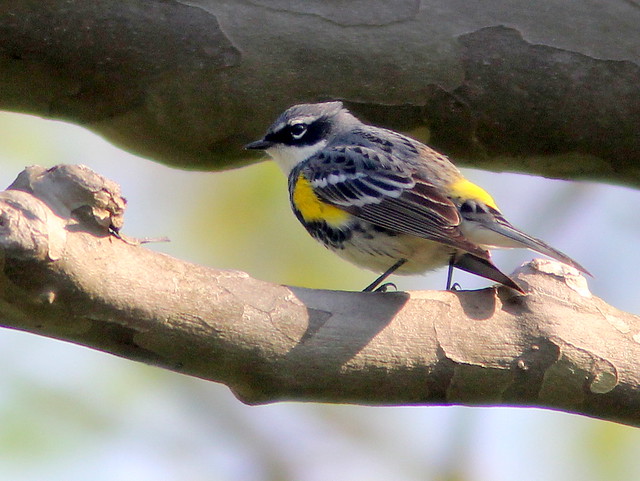
Although this is not a very sharp image, it is my first shot of a Blackburnian Warbler:
This Black-throated Green Warbler had just taken a bath:
A Magnolia Warbler posed nicely on a flowering tree:
In Florida, the warblers are usually silent, but this American Redstart at Aurora West Forest Preserve near our Illinois home was singing vigorously:
A female Yellow Warbler was busy gathering nest materials:
The male Yellow Warbler watched from a nearby perch:
Eastern Kingbirds had just migrated into Nelson Lake/Dick Young Marsh Forest Preserve, one of our favorite birding patches. Three kingbirds were gathered on a small tree in the prairie. Two were fighting while the third looked on. I presume they were two rival males
I have rarely seen an Eastern Kingbird display its usually-hidden red crest stripe, and this was my first opportunity to photograph this feature:
This has to be one of my favorite Northern Cardinal photos. The bird posed nicely in front of a tree trunk, thus cutting out the back light, and it also was a fine specimen with a clean bill: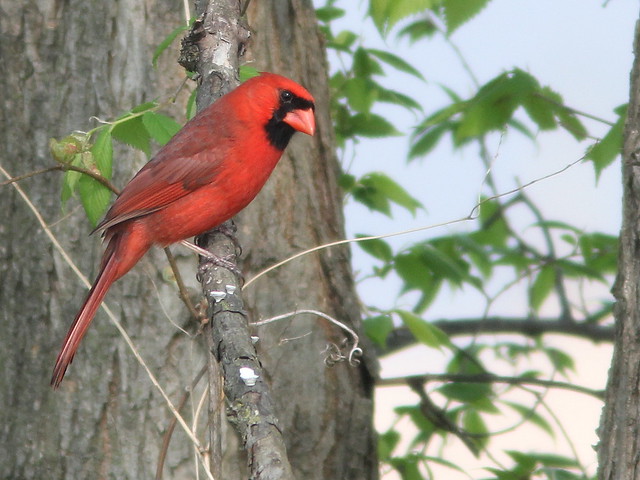
Posted by: Ken @ 10:02 pm
In south Florida we enjoyed a mild spring that provided some interesting birding in the wetlands next to our home. Before departing northward with the migrants, we got out nearly every morning.
Common Nighthawks were moving through. Two pairs seemed to take possession of separate territories along the gravel road that leads to the wild area. They took turns swooping down over our heads, startling us with loud “booms.”
One nighthawk perched on a wire overhead, depending upon balancing lengthwise, as its feet do not provide a very strong grasp:
The nighthawks provided me an opportunity to practice taking flight shots. Most photos showed only blue sky, as their flight is erratic and difficult to follow. I discovered that the best way to capture them in flight is to shoot with both eyes open– track with the left eye to keep the bird in the viewfinder with the right:
When perched lengthwise along a tree limb, or among dried vegetation on the ground, the protective coloration of nighthawks makes them almost invisible:
We had the driest winter on record. Water levels on the lake fell quickly, exposing mud flats and shallow pools, some of which trapped small fish, much to the delight of wading birds. The immature Reddish Egret, usually only found in coastal salt or brackish marshes, continued to entertain us with its antics.
Click on this 180 degree panorama of the lake and find a link to a large view that will scroll in your browser:
Here the egret uses both wings to shade the surface of the water, either to reduce the sun’s glare, and/or to induce unsuspecting fish to seek shelter in the shadow:
Black-necked Stilts announce the arrival of spring. 
We were visited by only one stilt, and it posed in front of the Reddish Egret, a Double-crested Cormorant and a White Ibis: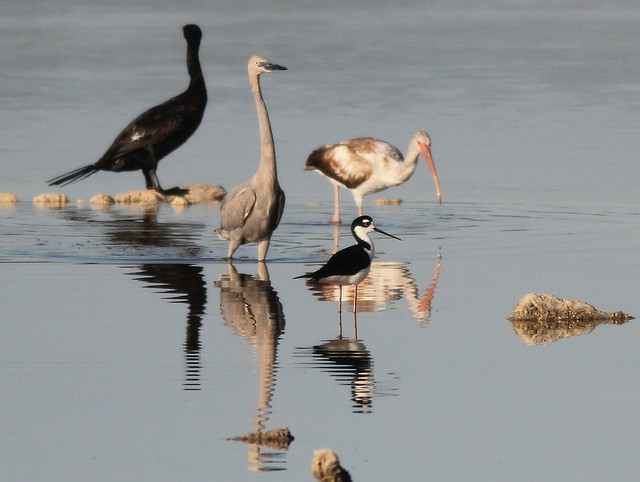
A Tricolored Heron flew in just as the stilt departed: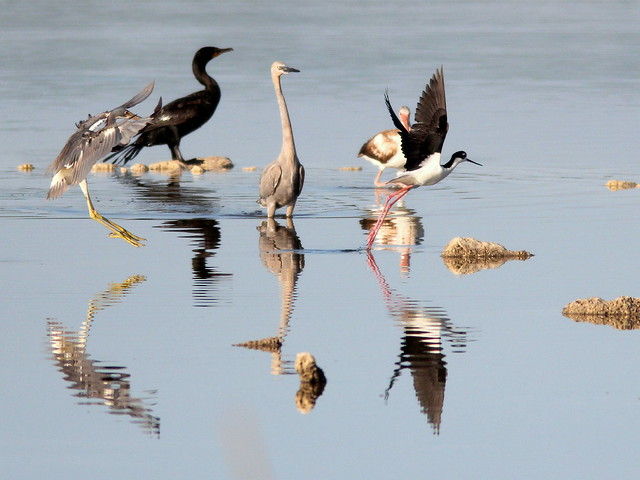
A flock of 30 small sandpipers settled down on the mud flats. Their stooped posture, warm brown backs, drooping bills and yellowish legs revealed them to be Least Sandpipers (click on photo for more views):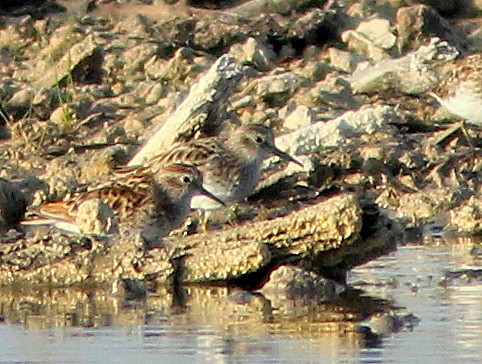
All at once, they took flight (click on photo for more views):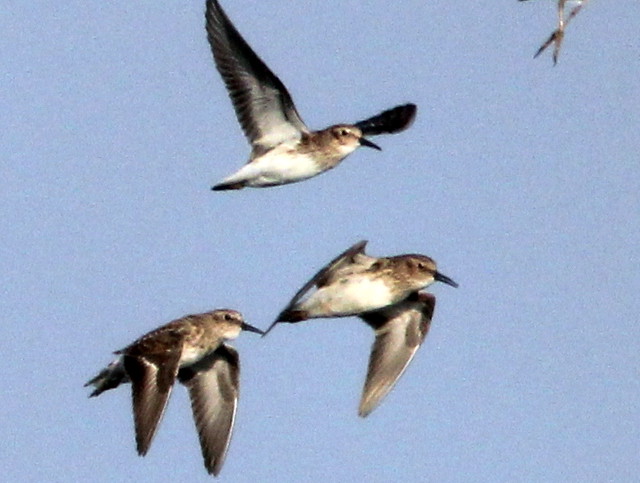
A larger, slender sandpiper continued foraging in one of the pools. It struck a graceful pose, revealing its bright yellow legs and long, slightly upturned bill, features of a Greater Yellowlegs:
A pair of Killdeer were courting when an interloper suddenly flew in. It expanded the upper black band on its neck as a threatening display, before being chased off by the male (click on photo for more views):
A nearby Semipalmated Plover looked somewhat like a small Killdeer, but has only one ring on its chest:
One morning, a White-tailed doe walked right up to me. She had a following wind and did not show signs of alarm until I moved my hand to adjust the camera settings. We do not see many deer, so this was a real treat: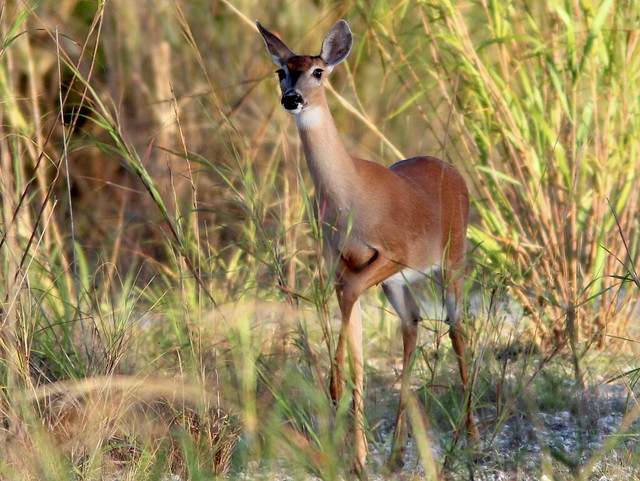
Before leaving Florida, we spent two nights at Marco
Island with our daughter’s family and her husband’s parents and other
relatives from Miami., boating and fishing. We
took a break from fishing to briefly visit Big Cypress Bend boardwalk in
Fakahatchee Strand. We encountered a Black Bear on the boardwalk not
more than 30 feet in front of us! I did not bring my big camera gear and
my Canon Powershot A40 was tucked away in its case.
What
a great place! Mary Lou actually gets credit for spotting the bear. As
usual, she was 20 paces ahead of me, while I was stopping to smell the
flowers. When she first spotted the bear she thought it was a black
garbage bag that someone had left on the boardwalk, As she got nearer,
it started to move– that’s when she called me and I came running. The
bear ran away from us on the boardwalk, its footsteps loudly banging on
the planks. It then jumped off to the right and hid in vegetation only
about 30-40 feet away. It stayed there for several minutes, until we
gave up and departed. My Point-and-shoot camera photo of the hiding bear
shows only a dark shadow.
I took this photo just before the bear encounter, and had just stored the camera back in my bag, so I missed a shot of the fleeing bear:
